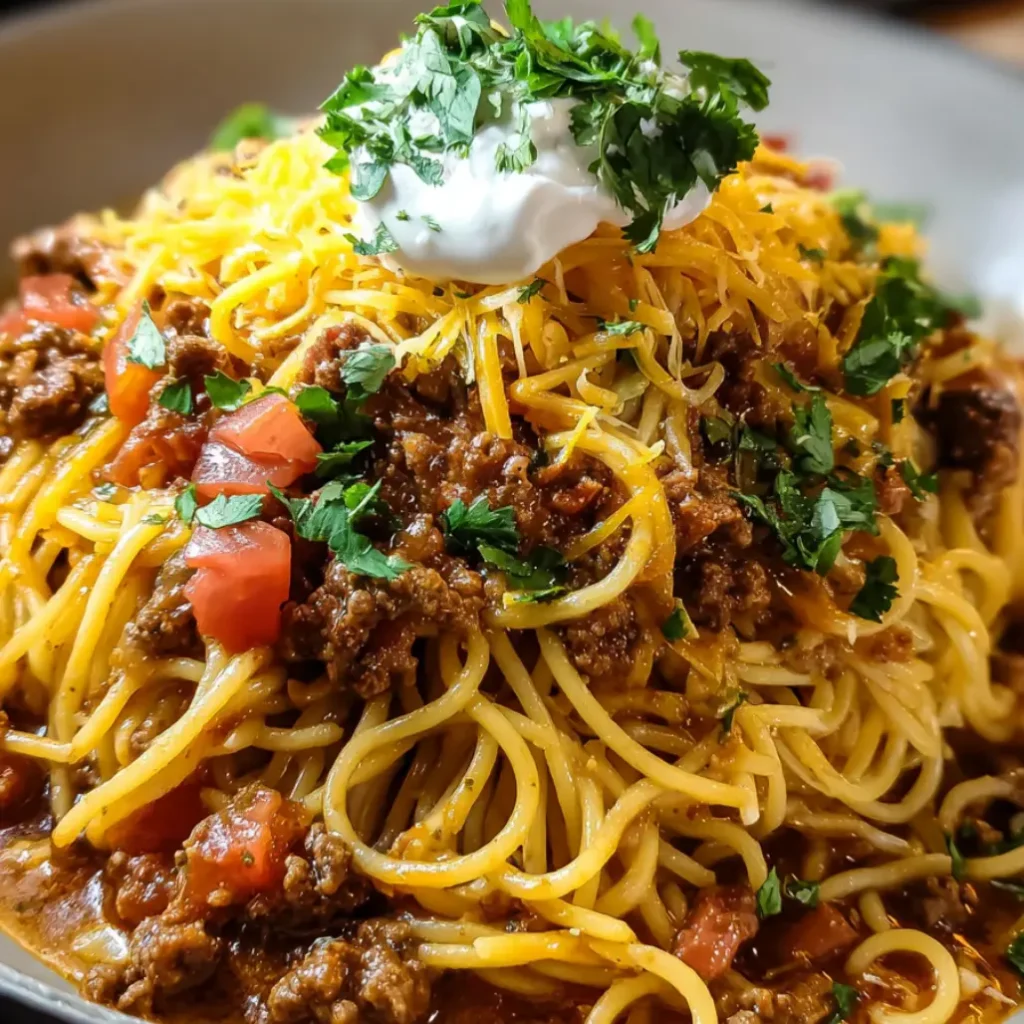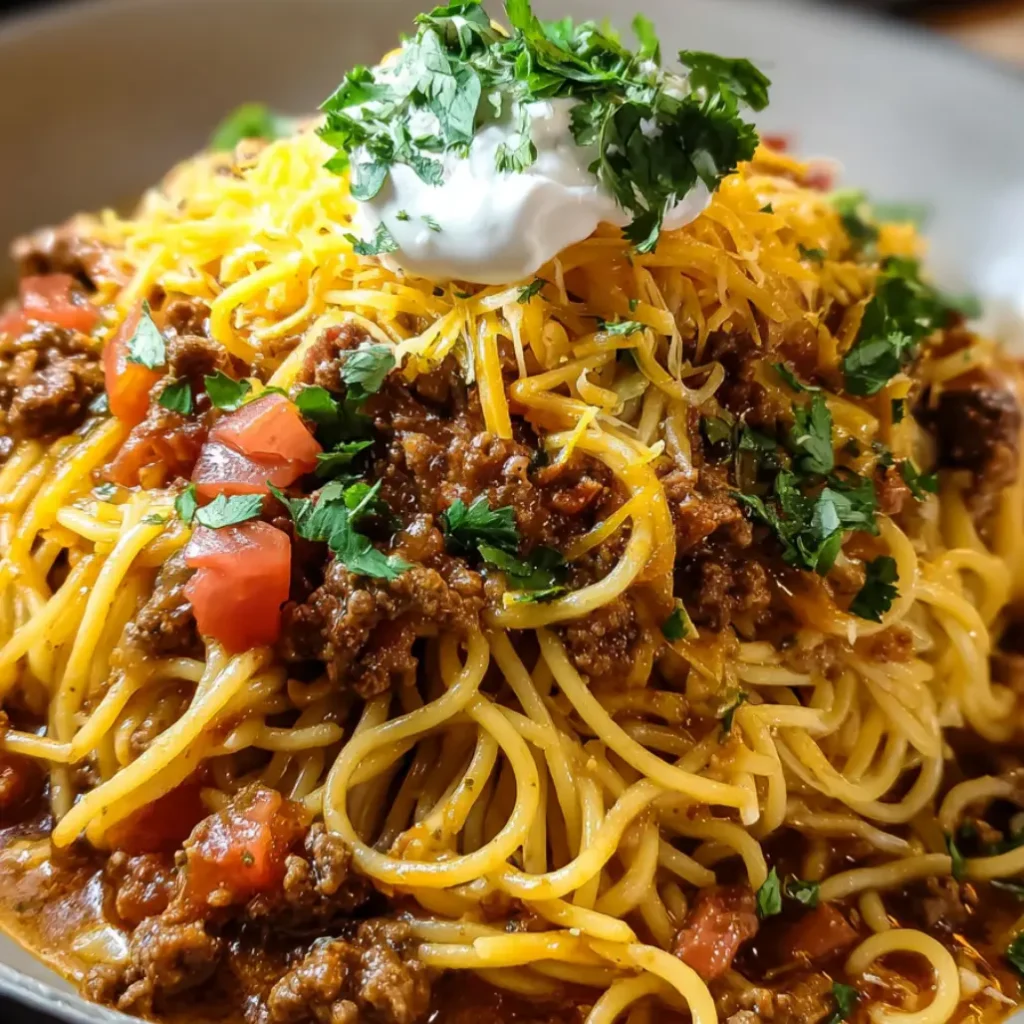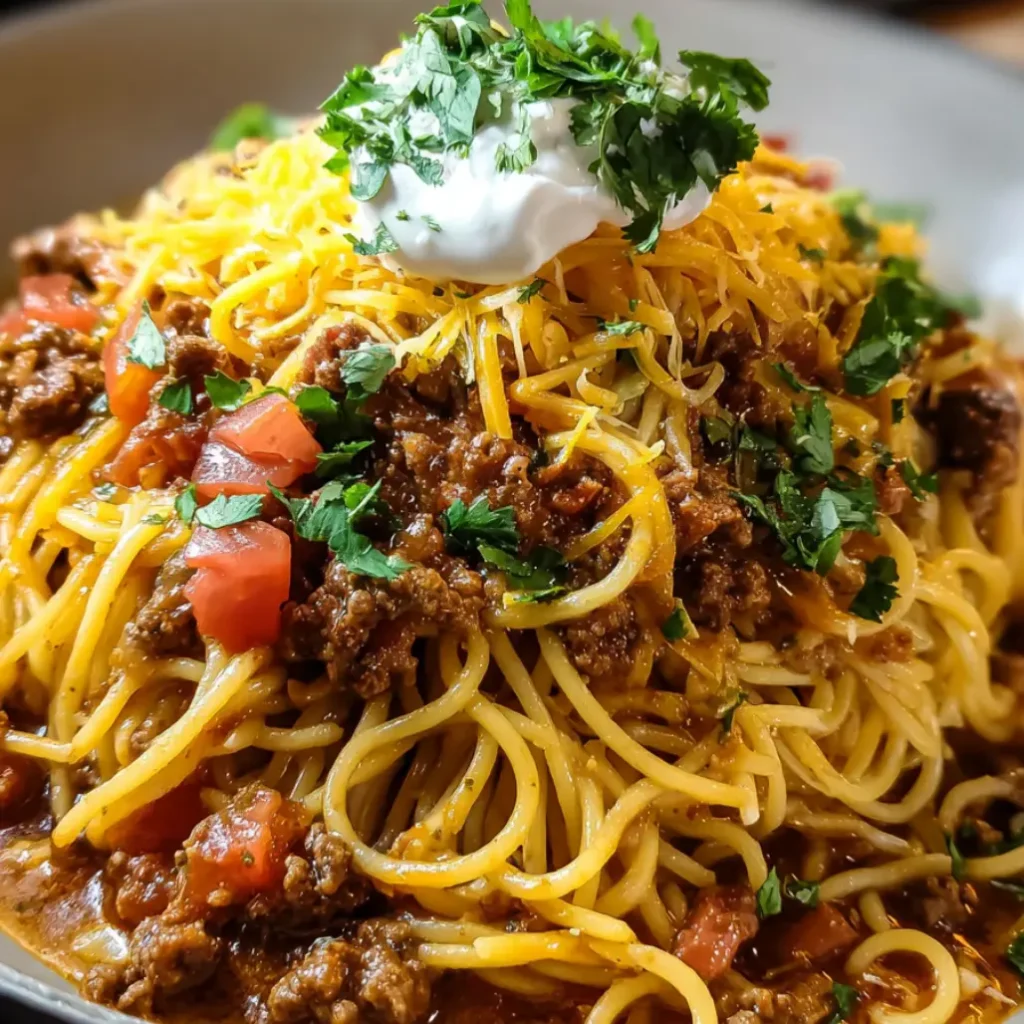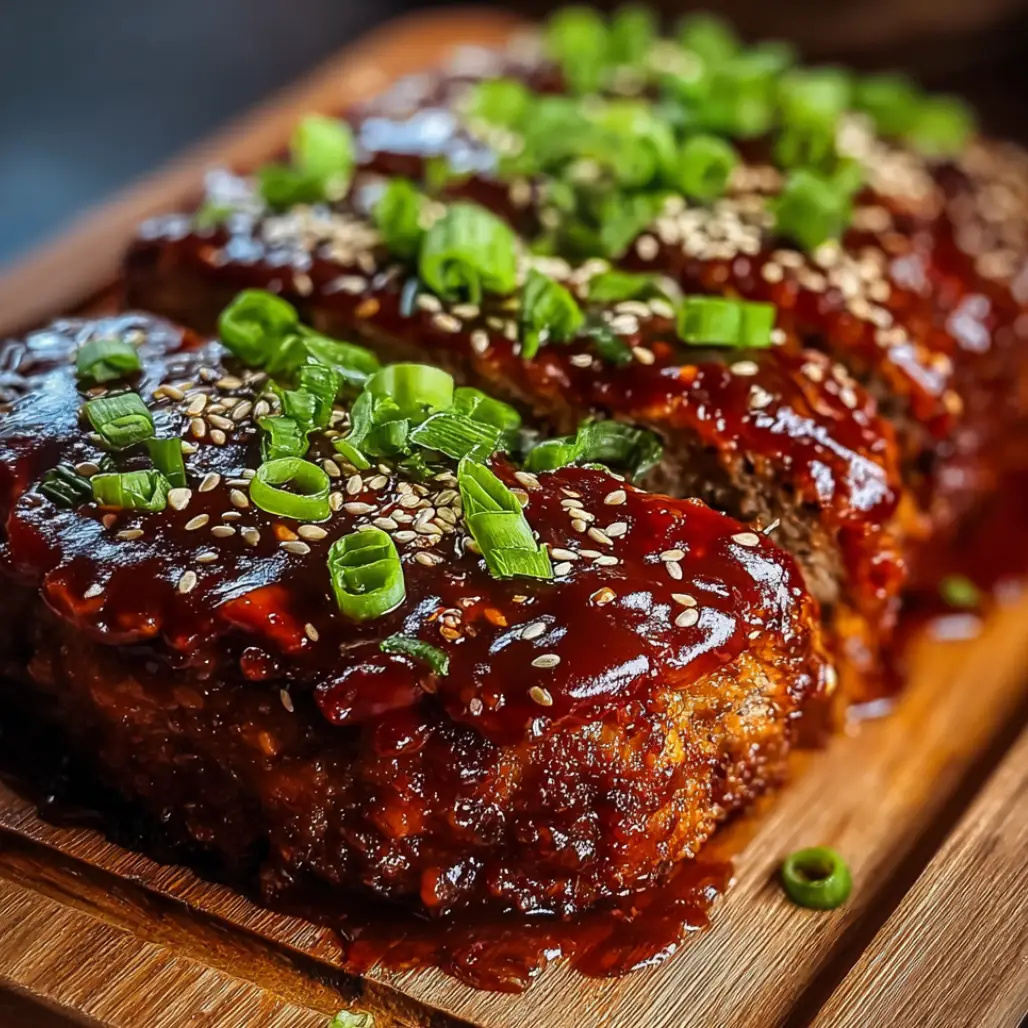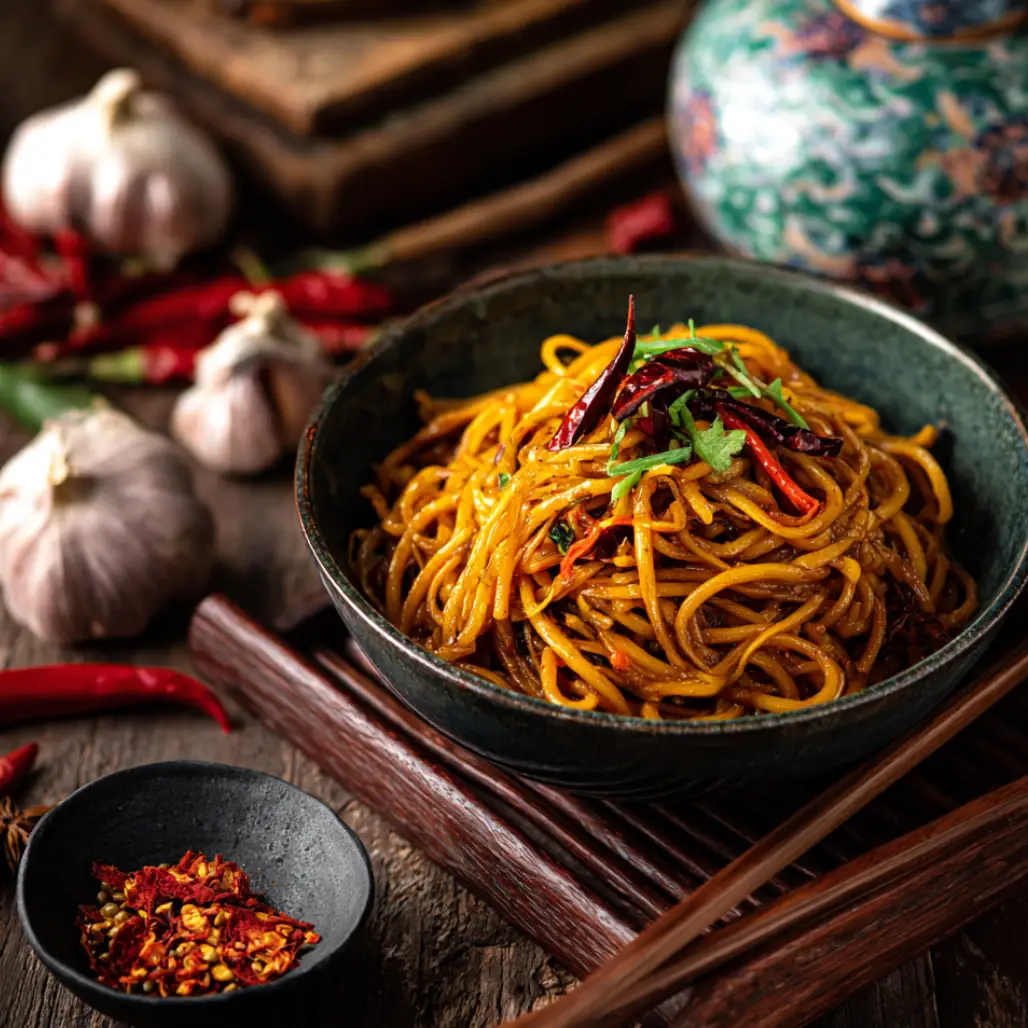| Prep Time: | 10 minutes |
|---|---|
| Cook Time: | 20 minutes |
| Total Time: | 30 minutes |
| Serves: | 6 |
When two beloved comfort foods collide in the most delicious way possible, you get taco spaghetti, a fusion dish that has been winning over families across America because it combines the familiar comfort of pasta with the bold, zesty flavors of Mexican cuisine in one satisfying skillet meal. This ingenious creation transforms ordinary weeknight dinner into something extraordinary because it delivers all the excitement of taco night while maintaining the comforting appeal of a hearty pasta dish that both kids and adults absolutely adore.
The beauty of this taco spaghetti lies in its simplicity and versatility because you can have a complete, satisfying meal on the table in just thirty minutes using ingredients that most families already have in their pantry and refrigerator. Unlike traditional spaghetti dishes that require multiple pots and lengthy preparation, this one-skillet wonder streamlines the cooking process because everything cooks together, allowing the flavors to meld beautifully while creating the perfect balance of protein, carbohydrates, and vegetables that makes for a well-rounded family meal.
Why This Taco Spaghetti Recipe Works
This particular approach to taco spaghetti succeeds brilliantly because it addresses the common challenges that home cooks face when trying to create satisfying weeknight meals that please everyone at the table. The recipe eliminates the need for multiple cooking vessels because the pasta cooks directly in the seasoned beef and tomato mixture, absorbing all those incredible flavors while saving you from extra dishes and cleanup time that nobody wants to deal with after a long day.
The flavor profile works so well because the taco seasoning blend provides the perfect foundation of cumin, chili powder, and paprika that transforms ordinary ground beef into something spectacular, while the addition of diced tomatoes with green chilies adds both moisture and a gentle heat that enhances rather than overwhelms the overall taste experience. The cheese component brings everything together because it creates a creamy, binding element that coats each strand of pasta while adding richness that balances the acidity from the tomatoes and the boldness from the spices.
Essential Ingredients
For the Base:
- 1 pound lean ground beef (90/10 or 93/7)
- 12 ounces spaghetti noodles
- 1 medium yellow onion, diced
- 3 cloves garlic, minced
- 2 tablespoons olive oil
For the Seasoning Blend:
- 1 packet taco seasoning (1 ounce)
- 1 teaspoon ground cumin
- 1/2 teaspoon smoked paprika
- 1/2 teaspoon garlic powder
- 1/2 teaspoon onion powder
- Salt and black pepper to taste
For the Sauce Components:
- 1 can diced tomatoes with green chilies (10 ounces, undrained)
- 1 can tomato sauce (8 ounces)
- 2 tablespoons tomato paste
- 2 cups beef broth
- 1/2 cup water
For the Cheese and Finishing:
- 2 cups sharp cheddar cheese, freshly grated
- 1 cup Monterey Jack cheese, shredded
- 4 ounces cream cheese, cubed and softened
- 1/4 cup fresh cilantro, chopped
- 2 green onions, sliced thin
Optional Toppings:
- Sour cream
- Fresh salsa
- Diced avocado
- Sliced jalapeños
- Hot sauce
The Art of Creating Perfect Taco Spaghetti
Mastering this taco spaghetti requires understanding the delicate balance between timing and technique because each component needs to cook properly while contributing to the overall harmony of flavors and textures that make this dish so irresistible. The key lies in building layers of flavor from the ground up, starting with properly browning the beef to develop deep, rich taste because well-browned meat provides the foundation that elevates this dish from simple weeknight fare to something truly special.
The pasta cooking technique differs significantly from traditional methods because the noodles cook directly in the seasoned liquid, which means they absorb flavor while cooking rather than simply serving as a neutral base for sauce. This integration creates a more cohesive dish because every element works together harmoniously, with the pasta becoming an integral part of the flavor profile rather than just a vehicle for carrying other ingredients.
Temperature control throughout the cooking process ensures optimal results because gentle simmering allows the flavors to develop while preventing the cheese from separating or the pasta from becoming mushy. The timing of cheese addition is crucial because adding it too early can cause curdling, while adding it too late might not allow for proper melting and integration that creates the creamy, cohesive texture that defines perfect taco spaghetti.
Step-by-Step Instructions
Step 1: Prepare Your Workspace and Ingredients Begin by gathering all ingredients and preparing your workspace because having everything ready ensures smooth cooking and prevents overcooking while you search for missing components. Heat a large, deep skillet or Dutch oven over medium-high heat and add the olive oil, allowing it to shimmer slightly because properly heated oil creates the ideal environment for browning the beef and developing those essential fond flavors that will enhance the entire dish.
Professional Tip: Choose a skillet that’s at least 12 inches wide and 3 inches deep because you’ll need adequate space for all the ingredients to cook evenly without overcrowding, which can lead to steaming rather than proper browning.
Key Points: Having a well-organized workspace prevents rushed cooking and ensures each step receives proper attention for optimal flavor development and texture achievement.
Step 2: Brown the Ground Beef Properly Add the ground beef to the heated skillet, breaking it apart with a wooden spoon or spatula as it cooks because smaller, uniform pieces brown more evenly and create better texture distribution throughout the finished dish. Cook the beef for 6-8 minutes without stirring too frequently because allowing it to brown properly develops the Maillard reaction that creates deep, complex flavors essential to exceptional taco spaghetti.
Professional Tip: Resist the urge to stir constantly because beef needs time in contact with the hot surface to develop proper browning, and moving it too often will result in gray, steamed meat rather than the golden-brown pieces that provide superior flavor.
Key Points: Properly browned beef should show golden-brown edges with no pink remaining, and the bottom of the pan should have developed some fond (browned bits) that will add depth to the sauce.
Step 3: Build the Aromatic Foundation Add the diced onion to the browned beef and cook for 4-5 minutes until the onion becomes translucent and begins to caramelize slightly because this creates sweetness that balances the bold spices while adding aromatic complexity to the dish. Incorporate the minced garlic during the last minute of onion cooking because garlic burns easily and bitter garlic can ruin the entire flavor profile of your taco spaghetti.
Professional Tip: If your pan seems dry during onion cooking, add a tablespoon of beef broth rather than more oil because this helps deglaze the fond while keeping the dish from becoming greasy.
Key Points: The onions should be soft and fragrant with golden edges, and the garlic should be aromatic but not browned, creating the perfect aromatic base for building complex flavors.
Step 4: Integrate the Seasoning Blend Sprinkle the taco seasoning, cumin, smoked paprika, garlic powder, and onion powder over the beef and onion mixture, stirring constantly for 30-60 seconds until the spices become fragrant because toasting spices briefly in the fat and fond enhances their flavors and prevents them from tasting raw or powdery in the finished dish. This blooming process is crucial because it develops the spice oils that create the distinctive taco flavor profile that makes this dish so appealing.
Professional Tip: Keep the heat at medium during spice addition because high heat can burn the spices and create bitter flavors, while too low heat won’t properly bloom the aromatic compounds that give taco seasoning its distinctive character.
Key Points: The spices should sizzle gently and release their aromas without showing any signs of burning or darkening beyond their natural color, indicating proper blooming without degradation.
Step 5: Add Tomato Components Strategically Stir in the tomato paste first, cooking it for 1-2 minutes until it darkens slightly because this concentrates the tomato flavor and removes any raw taste that can detract from the overall dish quality. Add the diced tomatoes with green chilies (including their juice) and tomato sauce, stirring to combine because the liquid components need to integrate with the seasoned beef mixture before adding the broth and pasta.
Professional Tip: When adding tomato paste, spread it around the pan and let it cook undisturbed for the first minute because this caramelization step deepens the tomato flavor and adds complexity to the sauce base.
Key Points: The tomato paste should darken to a deep red color and the mixture should be well combined with no streaks of paste visible, ensuring even flavor distribution throughout the cooking liquid.
Step 6: Create the Cooking Liquid Pour in the beef broth and water, stirring to deglaze any fond from the bottom of the pan because these browned bits contain concentrated flavors that will enhance the overall taste of your taco spaghetti. Bring the mixture to a rolling boil over high heat because you need vigorous bubbling to properly cook the pasta while maintaining the integrity of the sauce components.
Professional Tip: Use a wooden spoon to scrape up any stuck bits from the pan bottom because these caramelized pieces contain concentrated flavors that will significantly improve the depth and complexity of your finished dish.
Key Points: The liquid should bubble vigorously and all fond should be dissolved into the sauce, creating a cohesive cooking medium that will properly cook the pasta while infusing it with flavor.
Step 7: Cook the Pasta Directly in the Sauce Break the spaghetti noodles in half and add them to the boiling mixture, pressing them down with a spoon to ensure they’re submerged in the liquid because pasta needs to be covered to cook evenly and absorb the flavors properly. Reduce heat to medium-low, cover the skillet, and simmer for 12-15 minutes, stirring every 3-4 minutes to prevent sticking because direct pasta cooking requires more attention than traditional boiling methods.
Professional Tip: If the liquid level gets too low during cooking, add hot broth or water a quarter cup at a time because maintaining adequate moisture is essential for proper pasta cooking and preventing scorching.
Key Points: The pasta should be tender with just a slight bite remaining, and most of the liquid should be absorbed, creating a cohesive mixture rather than soupy consistency.
Step 8: Incorporate the Cheese Elements Remove the skillet from heat and immediately add the cubed cream cheese, stirring gently until it melts and creates a creamy base because residual heat is sufficient for melting while preventing separation that can occur with direct heat application. Add half of the cheddar and Monterey Jack cheeses, stirring until completely melted because gradual cheese addition ensures smooth integration without clumping or graininess.
Professional Tip: Add cheese off the heat and in stages because high temperatures can cause cheese proteins to seize and create a grainy texture instead of the smooth, creamy consistency that defines perfect taco spaghetti.
Key Points: The cheese should melt completely into the pasta mixture, creating a creamy, cohesive sauce that coats every noodle without any visible lumps or separation.
Step 9: Final Assembly and Presentation Sprinkle the remaining cheese over the top of the taco spaghetti and let it rest for 2-3 minutes to melt from residual heat because this creates an attractive presentation while adding textural contrast between the creamy interior and slightly firmer cheese topping. Garnish with chopped cilantro and sliced green onions because fresh herbs brighten the rich flavors and add visual appeal that makes the dish more appetizing.
Professional Tip: Reserve some of the fresh garnishes for individual serving because different family members may have varying preferences for cilantro and green onions, and fresh application maintains the best flavor and appearance.
Key Points: The finished dish should have a creamy, cohesive consistency with visible cheese melting on top and fresh green garnishes that provide color contrast and fresh flavor notes.
Professional Tips for Success
Understanding the nuances of one-pan cooking elevates your taco spaghetti from good to exceptional because this technique requires different approaches than traditional separate cooking methods. Always use lean ground beef because excess fat can make the dish greasy and interfere with proper pasta cooking, while lean meat provides better flavor concentration and healthier results that appeal to health-conscious family members.
Cheese selection significantly impacts the final result because different cheeses melt differently and contribute varying flavors to the overall profile. Sharp cheddar provides tang and complexity, while Monterey Jack offers mild creaminess, and cream cheese creates the smooth base that binds everything together because each cheese serves a specific purpose in creating the ideal texture and flavor balance.
For those seeking recipe inspiration beyond this taco spaghetti, explore our collection of perfect sides that complement Mexican-inspired dishes, or check out various savory sides that can round out your dinner menu with additional flavors and textures that enhance the overall meal experience.
Creative Variations to Explore
Transform this basic taco spaghetti into exciting new variations by incorporating different proteins or vegetables that complement the fundamental flavor profile while adding nutritional value and visual appeal. Ground turkey or chicken work excellently as substitutes because they absorb the taco seasonings beautifully while providing leaner protein options that health-conscious families appreciate, though you may need to add slightly more oil during browning because these meats contain less natural fat than beef.
Vegetable additions enhance both nutrition and flavor complexity because bell peppers, corn, black beans, or diced zucchini integrate seamlessly into the cooking process while providing additional textures and colors that make the dish more visually appealing. Add firmer vegetables like peppers and corn with the onions, while softer vegetables like zucchini should be added during the last few minutes of cooking because different vegetables require different cooking times to achieve optimal texture.
Spice level customization allows you to tailor the dish to your family’s preferences because you can easily adjust heat by choosing mild, medium, or hot diced tomatoes with green chilies, or by adding fresh jalapeños, serrano peppers, or hot sauce according to individual tolerance levels. Consider exploring our snacks appetizers section for complementary Mexican-inspired small plates that can extend your taco spaghetti into a themed dinner experience.
Perfect Pairing Ideas
This hearty taco spaghetti pairs beautifully with lighter accompaniments that provide textural contrast and help balance the richness of the cheesy pasta dish because successful meal planning involves considering how different elements work together to create a satisfying dining experience. A crisp green salad with lime vinaigrette cuts through the richness while adding fresh vegetables and bright acidity that cleanses the palate between bites of the substantial main dish.
Mexican-inspired sides like cilantro lime rice, refried beans, or Mexican street corn complement the flavor profile while adding variety to the meal because these traditional accompaniments share similar spice profiles without competing for attention. Fresh guacamole and salsa provide cooling elements that balance the warm spices, while their smooth and chunky textures contrast nicely with the pasta’s consistency.
For beverage pairings, consider options that either complement or contrast the bold flavors because successful drink selection enhances the overall dining experience. Cold beer, especially Mexican lagers or wheat beers, provides refreshing contrast, while agua frescas or flavored waters offer non-alcoholic alternatives that cleanse the palate. Explore our refreshing beverages collection for additional pairing ideas that can complete your Mexican-inspired meal theme.
Discover More Fusion Favorites
Expand your fusion cooking repertoire by exploring other dishes that successfully combine different culinary traditions because understanding these combinations helps you develop confidence in creating your own unique recipes. Asian-Italian fusion dishes like sesame noodles with Italian herbs or Mexican-American combinations like enchilada pasta bake demonstrate how different cultural flavors can enhance each other when properly balanced and thoughtfully combined.
The principles that make taco spaghetti successful, such as building layers of flavor and balancing richness with acidity, apply to many other fusion creations because good cooking fundamentals transcend specific cuisines and can be adapted to countless combinations. Consider browsing our dessert recipes section for fusion dessert ideas that can complete your international-inspired meal with creative sweet endings that surprise and delight your dinner guests.
Fusion cooking allows creative expression while providing familiar comfort because it takes beloved flavors from different traditions and presents them in new formats that feel both exciting and comforting. This approach works particularly well for families with diverse taste preferences because fusion dishes often satisfy multiple flavor cravings in a single meal, making dinner planning easier while expanding everyone’s culinary horizons through gentle introduction to new flavor combinations.
Storage and Reheating Guidelines
Proper storage techniques ensure that your taco spaghetti maintains its delicious flavor and appealing texture for several days after preparation because this dish actually improves with time as the flavors continue to meld and develop in the refrigerator. Store leftovers in airtight containers for up to four days in the refrigerator because proper sealing prevents moisture loss and protects against absorption of other food odors that can affect the taste quality.
When reheating taco spaghetti, add a splash of beef broth or water because pasta tends to absorb moisture during storage, and additional liquid helps restore the original creamy consistency while preventing the dish from becoming dry or clumpy. Microwave individual portions in 30-second intervals, stirring between each heating cycle because gradual reheating prevents hot spots and maintains even temperature distribution throughout the dish.
For freezer storage, this taco spaghetti keeps well for up to three months when properly packaged in freezer-safe containers or bags because the cheese and pasta components freeze successfully without significant texture degradation. Thaw frozen portions overnight in the refrigerator before reheating because gradual thawing prevents moisture separation and maintains the dish’s appealing consistency when properly warmed for serving.
The Science Behind Perfect Results
Understanding the scientific principles behind one-pan pasta cooking helps explain why this taco spaghetti method produces superior results compared to traditional separate cooking approaches because the pasta absorbs flavors while cooking rather than simply serving as a neutral base. Starch release during pasta cooking naturally thickens the cooking liquid because the pasta releases starches that bind with the liquid components to create a cohesive sauce without requiring additional thickening agents.
Cheese melting behavior depends on both temperature and timing because different cheese types have varying melting points and fat contents that affect how they integrate into hot mixtures. Cream cheese melts at lower temperatures and provides emulsification properties that help other cheeses integrate smoothly, while aged cheeses like sharp cheddar require gentle heat to prevent separation and maintain smooth texture throughout the melting process.
The Maillard reaction that occurs during beef browning creates hundreds of flavor compounds that enhance the overall taste complexity because this chemical reaction between proteins and sugars develops deep, savory notes that cannot be achieved through other cooking methods. These compounds provide the foundation flavors that make taco spaghetti more satisfying than simply mixing cooked pasta with jarred sauce because homemade development of these flavors creates superior depth and complexity.
Troubleshooting Common Issues
Even experienced cooks occasionally encounter challenges when preparing one-pan pasta dishes like taco spaghetti, but understanding common problems and their solutions helps ensure consistent success every time you make this family favorite. If your pasta seems too dry during cooking, gradually add hot broth or water because pasta absorption rates vary depending on brand, age, and cooking conditions, and maintaining adequate moisture is essential for proper cooking and final texture.
Cheese separation or graininess usually results from excessive heat or rapid temperature changes because cheese proteins can seize when exposed to high temperatures or thermal shock. If this occurs, remove the pan from heat immediately and whisk in a small amount of cold cream or milk because gradual temperature reduction and additional fat can often restore smooth texture to separated cheese sauces.
Overly spicy results can be tempered by adding dairy products like sour cream or additional cheese because dairy proteins neutralize capsaicin compounds that create heat sensation, while sweet elements like a small amount of sugar or honey can also help balance excessive spiciness without masking the intended flavor profile. For additional recipe troubleshooting and cooking tips, consider exploring our flavored dips marinades section for related sauce-making techniques that apply to pasta dishes.
Additional Fusion Inspirations
Build upon your taco spaghetti success by exploring other creative fusion combinations that bring together different culinary traditions in harmonious and delicious ways because mastering fusion cooking opens up endless possibilities for creating unique family meals. Consider Asian-Mexican fusion with Korean beef tacos or Thai-inspired pasta dishes that combine coconut milk with traditional Italian techniques because these combinations demonstrate how different flavor profiles can enhance each other when thoughtfully balanced.
Breakfast fusion ideas like taco scrambled eggs over pasta or Mexican-inspired breakfast casseroles can extend your fusion cooking into different meals because the principles of combining complementary flavors work across all meal categories. For morning meal inspiration that incorporates similar fusion principles, explore our breakfast favorites collection for creative ideas that can start your day with exciting international flavors.
Mediterranean-Mexican fusion represents another exciting direction because ingredients like olives, feta cheese, and fresh herbs can complement traditional Mexican spices while creating unique flavor profiles that surprise and delight family members and dinner guests. These combinations work particularly well because both cuisines emphasize fresh ingredients, bold flavors, and satisfying comfort food elements that translate well across cultural boundaries and cooking techniques.
Conclusion
This taco spaghetti represents the perfect marriage of convenience and flavor because it delivers restaurant-quality taste using simple techniques and readily available ingredients that busy families can easily incorporate into their regular meal rotation. The one-pan approach eliminates the stress and complexity often associated with elaborate dinners while ensuring that every component contributes to a cohesive, satisfying meal that pleases adults and children alike because successful family cooking should bring people together rather than create kitchen stress.
Mastering this taco spaghetti technique provides a foundation for countless other fusion experiments because understanding how different flavors and cooking methods work together empowers you to create your own unique combinations that reflect your family’s preferences and dietary needs. The skills you develop while perfecting this dish, from proper browning techniques to cheese incorporation methods, transfer directly to many other recipes because good cooking fundamentals remain consistent across different cuisines and preparations.
Whether you serve this taco spaghetti as a weeknight dinner solution or a casual entertaining option, remember that the best meals are those that bring family and friends together around the table because food serves as more than just nourishment when it creates opportunities for connection, conversation, and the simple pleasure of sharing something delicious with people we care about.

